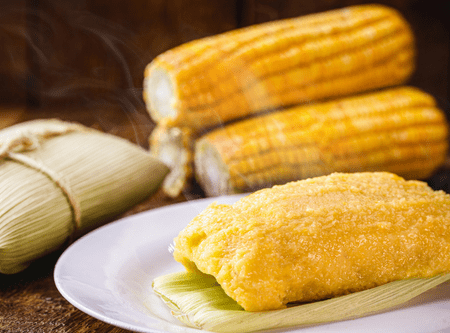Brazilian Sweet Corn Tamale Recipe
Pamonhas are a unique Brazilian dish made from sweet corn. Like many other corn dishes, they are widely consumed during the Festas Juninas, since the festival coincides with the nation’s second harvest of corn. But the pamonha is also eaten year round as a simple, delicious treat that can be customized to suit any taste.
Where Did Pamonha Come From?
Pamonha are first recorded as having been made and eaten in the Minas Gerais region of Brazil. Although it was probably consumed well beforehand, the first recipes for pamonha arose during the 19th century.
The name “pamonha” likely comes from the Tupi language, an indigenous language of South America. In the Tupi-Guarani dialect, the word pa-muna translates in English to “sticky,” which might describe the consistency of the dish.
Pamonha vs Tamales
Pamonha shares certain characteristics with the tamale, a traditional dish of Mesoamerican origin. Both the pamonha and tamal utilize a corn-based paste that is steamed or boiled within a corn husk. Both can be filled with various ingredients, like meat or vegetables.
The main difference between a pamonha and a tamal is the type of corn that is used and how it is processed. Tamales use masa, a mixture made from field corn that has been dried then soaked in an alkaline solution (usually limewater). The soaked kernels are rinsed with water, and the resulting product is called hominy. Hominy can be ground into a fresh dough or dried into a meal known as masa harina. For tamales, masa is blended with spices, water or stock, and lard.
Pomonha, on the other hand, uses fresh, sweet corn as the main ingredient. Sweet corn has a naturally higher sugar content, which means it lends itself to dessert dishes. Traditional pamonha, for example, are made with grated coconut, coconut milk, butter, and sugar and served as-is for a sticky, sugary treat.
Are Pamonha Always Sweet?
While traditional pamonha are often sweet, you can easily adapt this recipe to accommodate savory fillings. Pamonha salgada, for example, is a cheese-filled variation. It uses less sugar in the dough and adds parmesan cheese and a good amount of melty white cheddar. (It is not dissimilar in taste to Brazilian cheese bread.)
The simplicity of the basic recipe for pamonha means you can customize it however you like. Experiment with different flavors and fillings and have fun with it!
Pamonha Recipe
Ingredients:
4 cups fresh, sweet corn kernels (about 6-7 ears of corn)
¼ cup masa harina
5 oz unsweetened coconut milk
1 ¼ cup white sugar
½ tsp salt
4 oz grated sweetened coconut
2 tbsp melted butter
Corn husks for wrapping
Corn straw or kitchen twine for tying
Directions:
- Peel the husks from your corn. Rinse the larger leaves and put them in a saucepan. Cover the husks with water and bring the pan to a boil. Cook for three minutes, then remove the pan from the heat and set it aside.
- Slice off corn kernels with a sharp knife.
- When you have enough corn kernels, place them in a blender with the coconut milk and blend until a smooth liquid forms. Add the sugar, salt, butter, grated coconut, and masa and blend until smooth.
- At this point, the mixture should be sticky, but malleable. If your mixture is too liquid, add a little more masa. If it is too tough, add a little more coconut milk.
- Put a blanched corn husk with the glossy side up onto the counter. The wide end should be facing away from you.
- Spread about ¼ cup along the top half of the corn husk. A good method is to scoop the amount you want using a spoon, then put a layer of plastic wrap over the dough and press it down using your fingers.
- Fold one long side of the husk over the dough, then the other long side. Finally, bring the bottom half up to form a pouch. Secure with corn straw or twine.
- Continue this process until you have used all of your dough.
- Put your pamonhas in a large saucepan and cover with water. Bring to a boil then reduce the heat to medium-high. Simmer for about 45 minutes, or until the husks begin to take on a yellowish appearance.
- Remove the pamonha from the water and let them cool slightly before serving.

